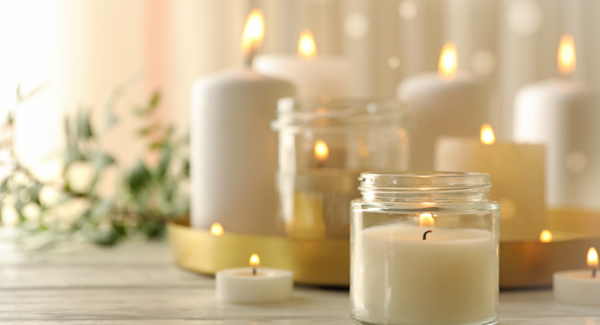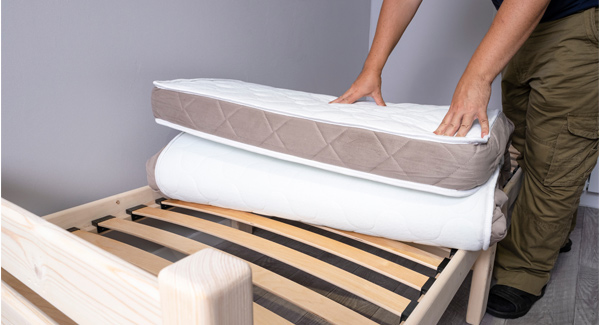Article navigation
- Published:
- Written by: Tony Brown
- Topic: Sleep
Candles create a calm, relaxing environment and can positively affect our mood. There’s nothing quite like the warmth and glow of a flickering flame to help you unwind at the end of a long day.
Candles can be used in various settings, from the bedroom to the living room, to create a warm and inviting ambience. However, as much as candles are popular for their soothing effects and ability to create a relaxing atmosphere, leaving a candle burning overnight is dangerous and can be hazardous to your health.
What are the benefits of burning candles?
Candles have been used for centuries for their calming and soothing effects. Burning candles in the bedroom can have several benefits.
Candles lift or enhance the mood
There’s something quite alluring about a flickering flame. A few well-placed candles around the bedroom create a warm and welcoming setting. Aromatherapy candles containing essential oils, such as lavender and peppermint, can relax the body and improve your mood.
Ambiance
Candles add warmth and light to the bedroom, especially on a cold or gloomy day. Candles bring a touch of romance to the home and are a great way to celebrate special occasions or show affection for your partner.
Fragrance
Candles fill the bedroom with pleasant smells and can mask unwelcoming odours. Scented candles are available in various scents to suit your mood and preferences, such as floral, fruity, and spicy.
Relaxation
Candles can help you relax and de-stress at the end of the day by creating a tranquil and calm setting. Some scents like lavender and sandalwood can help promote relaxation. You can also use candles for meditation, yoga, and aromatherapy to improve your well-being.
Bedroom decor
Candles brighten up the bedroom and create a warm and cosy sleep environment. They come in various styles to complement any bedroom décor.
What are the risks of sleeping with a candle burning?
While candles create a cosy bedroom environment, it’s important to be aware of their potential risks. Though it may be tempting to drift off to sleep with the flicker of a candle, there are several dangers associated with sleeping with a candle burning, including unstable flames, fire hazards, and health concerns.
Unstable flame
When a candle burns for too long, carbon may collect on the wick. The wick may become unstable and produce a potentially dangerous flame. A turbulent candle flame may also start to smoke and release soot, which can be harmful if inhaled. Additionally, if the candle is placed in a container, the heat can cause the container to crack or shatter, which can create a fire hazard or result in hot wax spilling out.
The candle may get knocked over
Candles can easily get knocked over by wind, draughts, children or pets, especially if placed on unstable surfaces or near doors and windows. An unattended candle can be dangerous if it gets knocked over and could potentially cause harm to others. The candle can quickly start a fire if it falls onto a flammable surface.
Inhaling smoke from candles
Burning candles emit pollutants such as benzene and toluene, which can be harmful if inhaled in large quantities. These pollutants can irritate the eyes, throat, and lungs, causing respiratory problems, headaches, and nausea. People with asthma or other respiratory conditions are particularly vulnerable to the effects of candle smoke.
Risk of fire
Candles pose a significant fire hazard, especially if left burning overnight. A lit candle can ignite nearby objects, such as curtains, bedding, or clothing. Once a fire starts, it can quickly spread throughout the room, putting everyone in the house at risk. In worst-case scenarios, candle-related fires can be fatal.
Wax spills
Candles can also create a mess if the wax spills onto surfaces or bedding. Wax can be difficult to remove and may stain or damage fabrics. Additionally, hot wax can cause burns or injuries if it comes into contact with the skin.
Candle safety tips
Never leave a burning candle unattended, even for a short period. Always refer to the manufacturer’s instructions and warning labels when burning candles. Here are some general safety guidelines to follow.
- Always put candles on a stable, heat-resistant surface.
- Place candles in proper holders and ensure the holders are stable and won’t tip over easily.
- Position candles away from anything that can catch fire, such as bedding, curtains, paper, or furniture.
- Don’t place candles under shelves or other surfaces, as the burning candle can generate a lot of heat, which can cause the surface to catch fire.
- Keep candles at least 4 inches apart to prevent them from melting each other and causing a fire.
- Burn candles in a well-ventilated room to avoid excessive smoke or soot build-up.
- Keep the candle out of reach of children and pets.
- Avoid burning candles for longer than four hours to prevent overheating.
- Don’t move candles while they are burning, as this can increase the risk of accidents and injuries.
- Never leave a burning candle unattended, even for a short period. Always keep the candle in sight when it is burning.
- Use a snuffer or a spoon to extinguish candles, rather than blowing them out, which can send sparks and hot wax flying.
- Double-check that candles are completely extinguished before leaving the room or going to sleep.
- Keep candles away from drafts, which can cause the flame to flicker and increase the risk of fires.
Safe alternatives to burning candles
If you’re concerned about the safety risks of burning candles in your bedroom, there are some alternatives.
Flameless candles
Flameless candles are a popular alternative to traditional candles because they allow you to enjoy the appearance and ambience of candlelight without the associated risks. They are typically battery-powered and use LED lights to produce a lighting effect that mimics the look of a real candle flame.
Unlike traditional candles, flameless candles do not melt. They are, therefore, safer as they do not produce smoke, soot, or dripping wax. So, you don’t have to worry about accidentally leaving a burning candle on and falling asleep.
Bedside table lamps
Table lamps are an effective way to enhance and illuminate your bedroom space. They offer a soft, warm glow that can make the bedroom feel brighter and more welcoming. Table lamps come in various styles, from classic to modern, so you can choose the style that complements your bedroom décor.
Unlike traditional candles, table lamps do not pose a fire risk, making them safer for families with children or pets.
Wax warmers
Wax warmers are devices that use heat to melt the wax, releasing fragrances into the air. Unlike traditional candles, wax warmers do not have an open flame, making them safer and cleaner. Wax warmers also have temperature control settings, which allow you to adjust the heat level and prevent overheating or scorching of the wax. They come in various styles and designs to suit your preferences.
Incense
Incense is a substance that is burned for its aroma. It is typically made from natural ingredients, such as gums, resins, and essential oils. There are various forms of incense, such as sticks, cones, and loose powder. Incense releases a pleasant aroma to create a relaxing and calming environment.
Reed diffusers
Reed diffusers are a popular alternative to normal candles. They use natural reeds that continuously release a subtle fragrance into the air. Reed diffusers work by placing the reeds into a bottle of scented oil. They do not require a flame, making them safer to use. Reed diffusers are long-lasting and do not leave any residue like candles can.
Potpourri
Potpourri is a mixture of dried petals, herbs, and spices placed in a decorative bowl or sachet to add fragrance to a room. It is a safe and natural way to freshen up the bedroom.
How to create a relaxing bedroom environment without candles
Candles can help create a relaxing bedroom environment, but other factors can contribute to a peaceful and restful sleep.
Light in the bedroom
Most people sleep better in a dark environment, so investing in blackout curtains can help block out the early morning light. It’s also important to avoid artificial light from appliances as these can disrupt sleep patterns.
Temperature
Temperature is also a key factor in creating a comfortable sleep environment. While children and older adults may require a warmer bedroom, the ideal temperature for most people is around 16-18 degrees Celsius.
Noise
Noise can also disrupt sleep, so you should aim to block out outside noises as much as possible. A fan or white noise machine can help create a quieter environment and promote better sleep.
Bedroom clutter
A cluttered bedroom can also have a negative impact on sleep and may also increase anxiety. Keep your bedroom clutter-free and reserved for relaxation and sleep.
Bedroom décor
When it comes to your bedroom décor, choose colours that evoke feelings of warmth and calm. Though colour itself does not affect sleep quality, certain bedroom tones can help create a calm sleep environment.
Mattress and pillows
Finally, investing in quality bedding, including a supportive mattress and pillows, can significantly improve sleep quality. You should be looking to replace your mattress every seven to ten years, as well as your pillows, which should be replaced every two to four years.
Final thoughts
It only takes one accident to cause a fire. While candles create a cosy and relaxing atmosphere, using them safely and responsibly is important. Avoid sleeping with candles burning, and never leave them unattended.
Share this article

About the author
Tony Brown is the founder and creator of The Bed Consultant. His career in the bed industry began in 2002. After graduating from university with a degree in Business Administration, Tony joined one of the largest independent furniture retailers in the UK as a bed consultant. Tony has helped thousands of customers find the perfect mattress.





